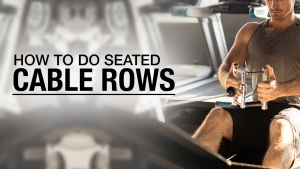
PROPER FORM FOR SINGLE ARM LAT PULLDOWNS
Looking for challenging movements for your back workouts?
Something different than what you see everyone doing at the gym like the regular Lat Pulldown, Barbell Pullover, Assisted Pull-up and Barbell Row?
The Single-Arm Lat Pulldown is your ticket to next-level back development, letting you fine-tune your form, engage your lats deeper, and avoid the compromised positions that come with the traditional bar setup.
We’re talking about a move that brings more than just more pulley weight to the table—it’s about precision, position with control, and pushing your muscles to their max.
Why stick to the same old two-arm routine when you can switch things up with a personalized range of motion using heavier weights or perfect those overhead movements?
Whether you’re using a neutral grip, palms-down grip, or even a fat grip, this exercise’s customizable grip options and grip variations mean you can target your lats from all angles, making every rep count.
So, if your usual pulldown machine is busy or you’re tired of half-hearted rep ranges, it’s time to learn the single-arm variation that’ll take your back training to the next level.
From proper shoulder positioning to dialing in on muscle fatigue with the right set-up position, we’ll show you exactly how to turn the Single-Arm Lat Pulldown into your new favorite back-builder.
Let’s get after it!
SINGLE ARM LAT PULLDOWN: MUSCLES WORKED
When it comes to maximizing the effectiveness of the Single-Arm Lat Pulldown, it’s not just about pulling the weight down—it’s about connecting your mind to every primary muscle involved in the middle regions of your back.
The primary working muscles here are the latissimus dorsi, but your results depend on your ability to dial in and focus on proper muscle activation with each rep.
This exercise isn’t just about moving weight; it’s about feeling every fiber in those lats stretch, contract, and work to maximize muscle size development.
If you’re just yanking the handle down without thinking, you’re missing out on gains. The mind-to-muscle connection is your secret weapon for building size and strength.
Visualize your lats pulling your arm down, not your biceps or shoulders taking over.
Keep your grip controlled and position your body to get the most out of that movement pattern.
This is where the Single-Arm Lat Pull variation shines—it forces you to concentrate on the lats alone, minimizing help from secondary muscle groups.
LATISSIMUS DORSI (THE LATS)

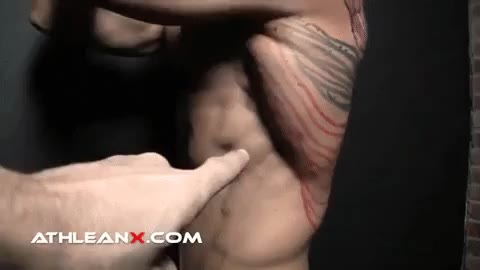
The Latissimus Dorsi, or lats, are the primary muscles targeted during Single-Arm Lat Pulldowns.
These complex muscles originate from a broad area, including the lower thoracic spine, iliac crest of the pelvis, and the lower ribs, and insert into the humerus, just below the shoulder joint.
This unique shape attachment makes the lats one of the most powerful muscles for shoulder adduction, extension, and internal rotation, making them crucial in pulling movement patterns.
During Single-Arm Lat Pulldowns, the lats are activated through a combination of vertical muscle fibers and horizontal muscle fibers, contributing to balanced muscle development and increased muscle size.
The unilateral approach enhances proper muscle activation and emphasizes muscle fatigue by isolating each side independently, allowing you to work through a personalized range of motion required to maximize the muscle action of this region.
The exercise capitalizes on the lats’ functions in shoulder extension and adduction, pulling the arm down and back towards the body’s midline.
This movement pattern directly engages the lat muscles more effectively compared to the standard Straight-Arm Pulldown, which often limit the range due to pieces of equipment constraints like bar attachments hitting the thighs.
By using a single cable machine and altering your grip and position, you get a fuller, deeper contraction that emphasizes the muscle’s ability to retract the scapulae, enhancing overall back muscle building and muscle hypertrophy.
HOW TO DO THE SINGLE-ARM LAT PULLDOWN
The Single-Arm Lat Pulldown isn’t just another back exercise—it’s a must for increases in muscle size and strength.
While most people flock to the pulldown machine, this variation’s range of motion epitomizes hitting your lats harder.
Is the pulldown machine busy? Not a problem! You can perform pulldown alternative exercises like Resistance Band Pulldowns.
This back exercise places an emphasis on muscle fatigue in all the right ways, making it a must-add to your muscle-building arsenal.
Let’s break down how to perform this fantastic movement to maximize gains and build serious back muscle through bodybuilding techniques.
SINGLE-ARM LAT PULLDOWN

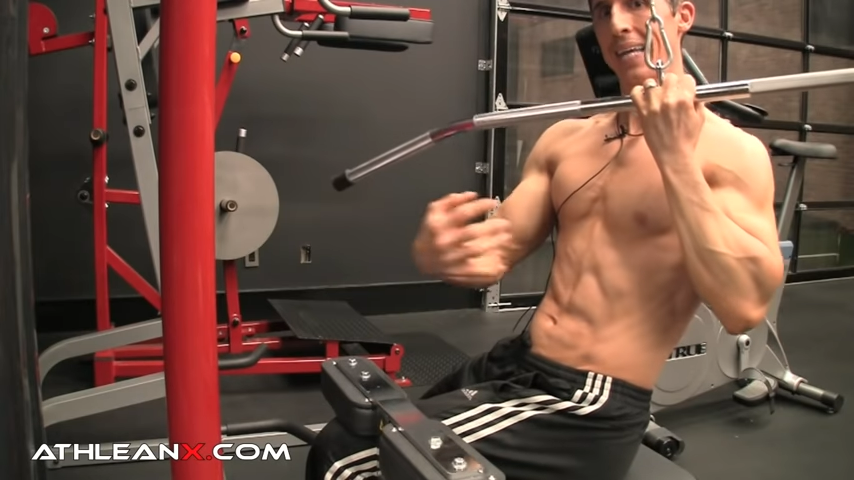
HOW TO DO A SINGLE-ARM LAT PULLDOWN:
- For the starting position, adjust the seat height on the Lat Pulldown machine so you can sit off to one side.
- Instead of sitting squarely, position yourself to allow for some rotation, adding that frontal plane stretch and a crucial side bending component. This tweak targets the latissimus dorsi muscles more effectively, helping with muscle imbalances.
- Anchor your left knee against the knee pad and grab the single cable handle (or the Lat Pulldown barbell attachment) with an overhand grip.
- As you pull the handle down, engage your core and rotate slightly in the opposite direction at the bottom of the movement. This action enhances the contraction of the largest muscle in your back—the lats—and emphasizes alternative muscle engagement through multi-directional muscle fibers.
- Focus on a complete range of motion throughout each rep during the Single-Arm Cable Pulldown. Keep your shoulder blades (scapulae) pulled down and back, maintaining proper shoulder alignment and positioning for maximum muscle growth.
WHAT MAKES IT EFFECTIVE: The One-Arm Lat Pulldown exercise boosts lat activation and minimizes biceps fatigue by incorporating rotation and altering your position. It enhances muscle function, corrects muscle imbalances, and offers a fuller range of motion, making it ideal for targeted back development and muscle hypertrophy, especially when Standard Lat Pulls fall short. Perfect for breaking routine, this move optimizes balanced muscle growth.
SINGLE-ARM LAT PULLDOWN COMMON MISTAKES
If you’re not getting the most out of your Single-Arm Lat Pulldown, chances are you’re making one of these classic mistakes.
This exercise is all about control, precision, and proper positioning—but one wrong move, and you’re leaving gains on the table.
Let’s dive into the most common pitfalls and how to correct them so you can load up those lats the right way.
POOR BASE STANCE POSITIONS
Whether you’re using seated, tall, or half-kneeling positions, your base stance matters.
Too often, people rush into the movement without setting up correctly, leading to a compromised flexed position that puts unnecessary strain on your shoulder.
Remember, proper shoulder positioning starts from the ground up. Lock in your stance to keep your shoulder in line for that perfect pull.
OVERLOADING WITH THE WRONG WEIGHTS
You might think heavier weights mean better gains, but if you’re sacrificing form, you’re just cheating yourself.
Stick with light weights to moderate weights that allow you to maintain control through the full range of motion, especially during the eccentric movements.
Loading recommendations for muscle strength are all about quality rep ranges, not just piling on weight.
INCORRECT GRIP VARIATIONS
The wrong grip can derail your progress faster than you think.
Using a pronated grip, narrow grip, or wider grip can all target the lats differently, but if your hands are positioned incorrectly, you’re missing out on key muscle activation.
Play around with grip options like the D-handle attachment or even a landmine attachment to find what works best for your body mechanics.
LACK OF SHOULDER ADDUCTION
A huge mistake is failing to maximize the lat dorsi in shoulder adduction, where you pull your shoulder blades down and back to engage the lats fully.
Without this, you’re just turning a powerful lat exercise into a mediocre shoulder movement.
Focus on pulling your hands to shoulder level with every rep for maximum muscle activation.
UNCONTROLLED MOVEMENTS AND MOMENTUM
Using bodyweight to swing or yank the weight down is a no-go.
This isn’t about bodyweight exercises like a Floor Pulldown or Plank with Shoulder Taps.
Each pull should be deliberate and controlled.
Avoid jerking motions or letting momentum take over—control the weight through the full movement pattern to get the best results.
IGNORING REGRESSION FOR PULL
Not everyone is ready for the full Single-Arm Lat Pulldown right out of the gate.
Don’t hesitate to use regressed versions like the Incline Cable Pulldown or focus on horizontal pull variations with minimal equipment to build strength gradually.
Master the basics before going full throttle on advanced versions.
SINGLE-ARM LAT PULLDOWN VARIATIONS
Let’s dive into some powerful variations that hit the outer region, emphasize muscle control, and fire up those lats like never before.
Here are my recommendations for Single-Arm Lat Pulldown variations that you can add into your routine.
These exercises are as effective for beginner-level Lat Pulldown alternative workouts as much as they are for advanced programs.
ONE-ARM CABLE PUSHDOWN

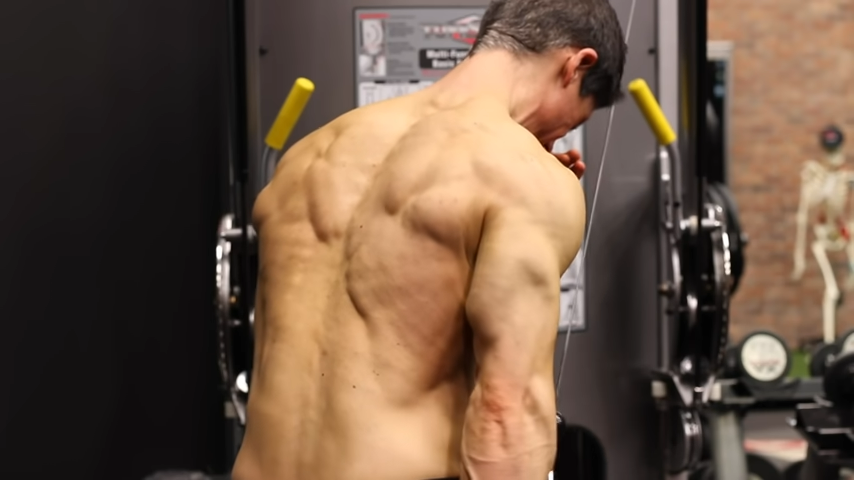
HOW TO DO THE ONE-ARM CABLE PUSHDOWN:
- Starting position is to stand facing the cable machine with your feet shoulder-width apart. Grab the handle with one hand using an overhand grip, and step back to create tension in the cable.
- Keep your torso slightly forward with a soft bend in your knees—this stance gives you a stable base and optimal leverage.
- Start with your arm extended, keeping a slight bend in your elbow. Engage your core and retract your shoulder blade (scapula) to set up for a powerful contraction.
- Drive your hand down and back towards your hip in a straight line, focusing on pulling with your lat, not your arm.
- At the bottom of the movement, bring your hand past your hips, going further than what the standard two-arm version normally allows.
- Squeeze your lats hard and feel that full contraction—this is where the magic happens. By doing this, you’re not just hitting the lats—you’re maximizing contraction and emphasizing muscle fatigue, leading to superior muscle fiber recruitment and balanced muscle development.
- Avoid letting your shoulder roll forward; maintain proper shoulder positioning for the best muscle engagement.
- Slowly return the handle to the starting position, resisting the pull of the cable to engage your lats even during the return.
WHAT MAKES IT EFFECTIVE: This is one of my favorite Lat Pulldown alternatives. The standard two-arm version with a straight bar attachment hits a roadblock when the bar stops short at your thighs, limiting your range of motion and muscle engagement. This single-arm approach allows you to go beyond the traditional stopping point, driving the shoulder back and extending your arm further behind your body. This extra adduction and extension activate those complex lat muscles like never before, targeting vertical and horizontal muscle fibers for enhanced muscle action and size development.
INCLINE SINGLE-ARM STRETCH PULLDOWN

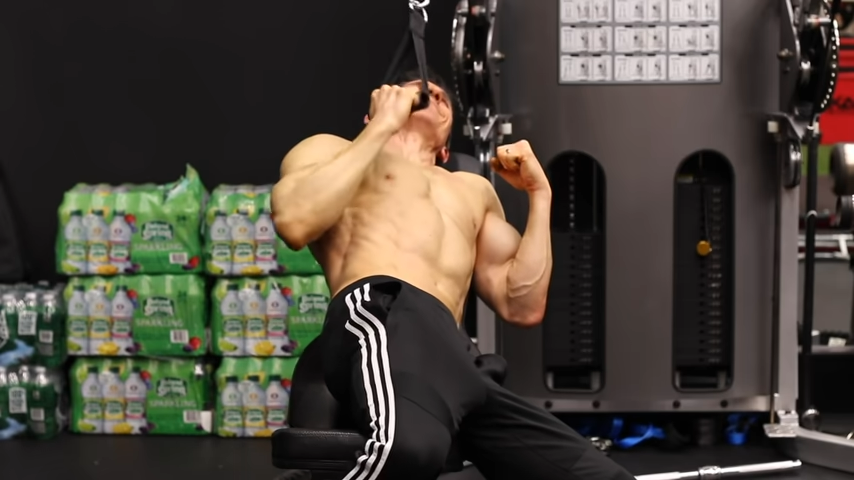
HOW TO DO THE INCLINE SINGLE-ARM STRETCH PULLDOWN:
- Position an adjustable bench at about a 45-degree angle facing a high cable pulley.
- Lie on your side on the bench, angling your feet and body towards the side you’re working. This setup allows for the optimal stretch and line of pull needed to target the lats effectively.
- With your body stabilized on the bench, let your working arm reach up and over your body, grabbing the cable handle, and feeling that deep stretch in the lats.
- Now, it’s time to pull. Focus on driving your elbow straight down towards your hip, keeping a clear line of movement that directly targets the lats.
- This elbow-to-hip movement is crucial; it’s not just about pulling the handle—it’s about initiating the movement with your lat to achieve that intense contraction.
- As you pull the cable handle down, really squeeze your lats at the bottom of the movement. Think about touching your elbow to your hip—this visualization will help you maximize the muscle engagement.
- As you return the handle back up, don’t just let the weight pull you. Control the eccentric phase, allowing your arm to go back over your body to feel that deep lat stretch once again.
WHAT MAKES IT EFFECTIVE: The incline position adds an extra element as your hips rotate slightly, enhancing the stretch through the entire lat muscle. This is the key—you’re setting up to maximize both stretch and contraction. This stretch and squeeze combo is what makes this exercise so effective.
The Single-Arm Lat Pulldown isn’t just another variation—it’s your back’s new best friend.
By incorporating rotation, personalized grips, and controlled movement, this exercise targets your lats in ways that Traditional Pulldowns can’t match.
Ditch the basics and take control of your back development—get your form right, focus on that mind-muscle connection, and watch your gains go through the roof.
Check out our ATHLEAN-X programs to see which is the best fit for your personal fitness goals and fitness level.

- Perfect for loading up on strength, correcting imbalances, and adding serious muscle to your back, the Single-Arm Lat Pulldown is a fantastic movement.
- Here’s how to do the Single-Arm Lat Pulldown:
- Adjust your seat height so you’re not sitting straight-on like everyone else. Shift to one side to allow a bit of torso rotation.
- That slight twist is key for hitting your lats in the frontal plane and fixing those nagging muscle imbalances.
- Anchor your left knee on the knee pad and grab the single cable handle or the bar attachment with an overhand grip. This setup locks you in for the perfect pull, making sure your lats are primed and ready.
- As you pull, think beyond just moving the weight—engage your core and rotate slightly away from the working arm at the bottom of the movement.
- This little tweak cranks up the contraction, firing up those multi-directional muscle fibers for next-level lat engagement.
- Each rep is all about control. Keep those shoulder blades locked down and back, no sloppy positions here. You’re working your lats, not letting your traps take over.
- Don’t cheat yourself on the range of motion. Pull all the way down, feeling that full stretch and contraction on every rep.
REFERENCES

Jeff Cavaliere M.S.P.T, CSCS
Jeff Cavaliere is a Physical Therapist, Strength Coach and creator of the ATHLEAN-X Training Programs and ATHLEAN-Rx Supplements. He has a Masters in Physical Therapy (MSPT) and has worked as Head Physical Therapist for the New York Mets, as well as training many elite professional athletes in Major League Baseball, NFL, MMA and professional wrestling. His programs produce “next level” achievements in muscle size, strength and performance for professional athletes and anyone looking to build a muscular athletic physique.
































